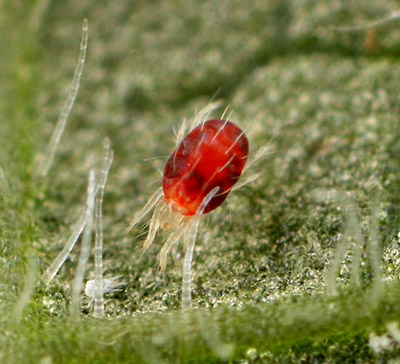Potato leafhoppers and mites on the rise in chestnut
Potato leafhopper numbers are up and European red mites are visible in Michigan chestnut orchards.

Potato leafhoppers in chestnuts
Like many plants, chestnuts are sensitive to the saliva of potato leafhoppers that is injected while feeding. Damage to leaf tissue can cause reduced photosynthesis, which can impact production, affect nut quality and damage the tree.
Scouting for leafhoppers should be performed weekly and also following storm systems originating in the south. The easiest way to observe potato leafhoppers is by flipping the shoots or leaves over and looking for adults and nymphs on the underside of leaves. Pay special attention to succulent new leaves on the terminals of branches. Growers may also hang yellow sticky traps in the orchard to catch potato leafhoppers. Be sure to hang traps on the edge and interior of the block.
The most common classes of insecticides recommended for control of potato leafhoppers include the pyrethroids, carbamates, neonicotinoids and organophosphates. Carbamates (e.g., Carbaryl, Sevin) and organophosphates (e.g., Imidan) are broad-spectrum and can disrupt natural enemies, so only use when necessary to rotate insecticidal mode of action or to target another pest at the same time. Pyrethroids (e.g., Brigade, Baythroid, Warrior and Mustang) are also effective at controlling potato leafhoppers and remain relatively inexpensive. However, pyrethroids have been shown to cause increases in mite populations in other crops and should be used judiciously, particularly early in the season when mite populations have time to build over the season. Neonicotinoids (e.g., Admire, Nuprid, Porvado and Assail) are longer lasting and narrow spectrum, making them a solid choice for management.
For more information on how to identify potato leafhoppers and symptoms of damage as well as management recommendations, please refer to the Chestnut Pest Management section of the Michigan State University Extension Chestnuts website. For a list of currently registered insecticides, see “Michigan Chestnut Management Guide 2016.”
European red mites in chestnuts
Chestnut trees are susceptible to feeding damage from European red mite. Affected leaves appear mottled, stippled or bronzed and become brittle, leading to early defoliation and reduced photosynthetic activity. Reduced photosynthesis can lead to reduced nut size and return crop load in subsequent years as well as increased sensitivity to winter injury. At this time, no treatment thresholds are established for mites in chestnut, but evidence from crops like cherries indicate some level of feeding is likely tolerable, and higher populations can be tolerated as the season progresses through summer.
European red mites overwinter as eggs in bark crevices and bud scales. Eggs are small spheres, about the size of the head of a pin with a single stipe or hair that protrudes from the top (this is not always visible). Eggs can be viewed with a hand lens or the naked eye once you have established what you are looking for. Growers can scout for overwintering eggs and early nymph activity in the spring to assess population levels in hotspots. As temperatures warm, overwintering eggs hatch and nymphs move onto the emerging leaves and start feeding.

Adult European red mite feeding on leaves. Photo: Scott Justis.
Adult European red mites are red in color and have hairs that give them a spikey appearance. Adult and nymph feeding occurs on the underside of leaves, so be sure to flip them over when scouting. This first generation is the slowest of the season and typically takes a full three weeks to develop and reproduce. This slow development is due to the direct link between temperature and mite development. Summer generations, favored by the hot and dry weather, are able to complete their lifecycles much faster with as little as 10 days between generations under ideal conditions.
When scouting, remember not all mites are bad. Consider documenting the levels of beneficials predatory mites in your orchard. If healthy populations of mite predators exist, they will continue to feed on plant parasitic eggs and nymphs and can be an effective component of your mite management program. The three most important predaceous mites are Amblyseius fallacis (Phytoseiidae), Agistemus fleschneri (Stigmaeidae) and Zetzellia mali (Stigmaeidae) (see “A Pocket Guide for IPM Scouting in Michigan Apples,” MSU Extension bulletin E2720, for pictures). Predaceous mites are smaller than adult European red mites and twospotted spider mites, but they can be seen with a hand lens and typically move very quickly across leaf surfaces.
Growers should limit the use of broad spectrum insecticides (e.g., pyrethroids) that have a negative impact on beneficial mite populations, which provide natural control. True miticides (e.g., Portal, Nexter, Envidor, Zeal) are a solid choice for controlling pest mites, with long residual control and low beneficial insect toxicity. Spot-treatments may be used for highly localized outbreaks. For a complete list of currently registered insecticides, see “Michigan Chestnut Management Guide 2016.”
Please continue to visit the MSU Extension Chestnut website and the MSU Chestnut News Facebook page for up-to-date information, and sign up to receive the news digest.
This material is based upon work supported by the National Institute of Food and Agriculture, U.S. Department of Agriculture, under Agreement No. 2015-09785. Any opinions, findings, conclusions, or recommendations expressed in this publication are those of the author(s) and do not necessarily reflect the view of the U.S. Department of Agriculture.



 Print
Print Email
Email

